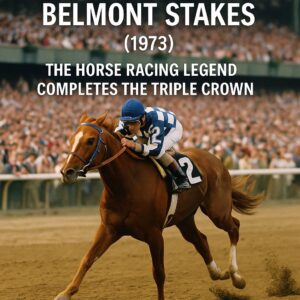It was June 9, 1973, a warm Saturday afternoon at Belmont Park in Elmont, New York. The grandstands were packed with nearly 70,000 fans, all brimming with anticipation. The air buzzed with electricity—not just because a Triple Crown was on the line, but because something more was in the wind. That “something” had a name: Secretariat.
No one could have predicted what was about to unfold. What happened that day wasn’t just a victory—it was a moment that transcended sport. It was a performance so dominant and so breathtaking that it stamped Secretariat’s name in the annals of history, not just as a great racehorse, but as a living symbol of excellence.
To truly appreciate what made that moment unforgettable, you have to rewind the tape. The Triple Crown—made up of the Kentucky Derby, the Preakness Stakes, and the Belmont Stakes—is one of the hardest feats in all of sports. Since 1948, no horse had managed to win all three. Many had tried. Many had come heartbreakingly close. None had sealed the deal.
Secretariat, affectionately nicknamed “Big Red” for his powerful chestnut frame, had already dazzled fans with his incredible burst of speed in the Kentucky Derby. He didn’t just win—he broke the 1¼ mile record with a time of 1:59⅖, a time that still stands. Just two weeks later at the Preakness, he went from dead last to first with an explosive mid-race move that left jaws on the floor. But the Belmont? The Belmont was different. It’s the longest of the three races at 1½ miles, and it has a reputation for breaking hearts. The distance alone can ruin even the strongest contenders. To win here, a horse doesn’t just need speed—it needs grit, stamina, and something extra you can’t measure.
As the gates flung open that afternoon, Secretariat and his fierce rival Sham lunged forward together, quickly pulling ahead of the rest. For a moment, it looked like it might be a duel. But then, something almost surreal began to happen. Secretariat didn’t just maintain his pace—he accelerated. With each thundering stride, he stretched the distance between himself and the field. By the time they hit the mile mark, Sham was fading and Secretariat was flying. His jockey, Ron Turcotte, didn’t urge him on—he didn’t have to. Secretariat was running like he knew history was watching.
As he rounded the final turn, Secretariat was so far ahead the camera had to zoom out just to keep him in the frame. Thirty-one lengths ahead. That number sounds fictional, like something out of a myth, but it happened. He crossed the finish line alone, in a time of 2:24 flat. That Belmont Stakes record still stands more than five decades later, untouched.
Some who watched that day say it was the greatest moment in horse racing history. Others go even further, calling it the most incredible athletic feat they’ve ever witnessed. And they might be right. Because Secretariat wasn’t just fast—he was transcendent. Watching him run was like witnessing the very idea of greatness in motion.
But what really made that race resonate wasn’t just the numbers. There was something emotional, almost spiritual, about it. You didn’t need to understand racing to be moved by what you saw. Across the country, people tuned in on CBS, and for two minutes and twenty-four seconds, the rest of the world seemed to pause. At a time when the nation was struggling with war, scandal, and economic uncertainty, Secretariat’s run was like a burst of pure, unfiltered joy.
Years later, Turcotte said he’d never experienced anything like it. Secretariat’s trainer, Lucien Laurin, called him “the greatest horse to ever look through a bridle.” And when that red colt thundered past the finish line, the roar from the crowd wasn’t just celebration—it was something closer to awe.
Secretariat’s Triple Crown win was the first in 25 years. But even after he retired from racing, the legend only grew. He became a household name, graced magazine covers, and eventually starred in his own Disney film. In 1989, when he passed away at the age of 19, an autopsy revealed that his heart weighed nearly 22 pounds—more than twice the average size. Some believe that enormous heart explained his incredible stamina and power. Others took it as something symbolic. Secretariat had heart in every sense of the word.
Today, his name is synonymous with greatness. His statue stands at Belmont Park, a permanent tribute to the day he rewrote the rules of what’s possible. Every June, as the Belmont Stakes approaches, fans and newcomers alike revisit that race, reliving the magic of a horse who ran not just to win, but to inspire.
And that’s why this story still matters. In an age dominated by data, stats, and highlights, Secretariat’s 1973 Belmont reminds us that some moments defy numbers. You didn’t need a betting slip or a racing form to understand what you were watching. It was the kind of performance that sticks with you, the kind you tell your kids about, the kind that turns sport into legend.
So today, June 9, take a moment to remember the day Secretariat didn’t just win a race. He galloped into immortality.

